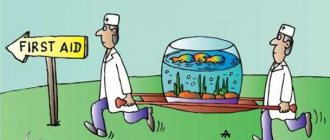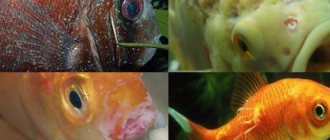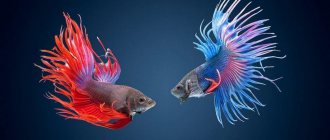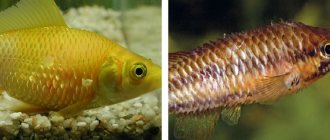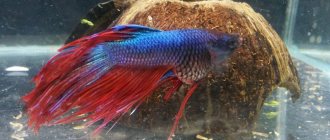Aquarium fish, like residents of open water bodies, are susceptible to various diseases. In an aquarium it is much easier to diagnose the disease and begin treatment on time.
How to recognize the main contagious and non-contagious diseases of aquarium fish, and what means to use to combat them, you will learn from our article.
- Alkaline disease of aquarium fish
Contagious diseases
As mentioned above, infectious diseases are provoked by a pathogen (bacteria, fungus, etc.). Depending on the type of disease, characteristic symptoms of the pathology appear.
In order to diagnose the disease in time and carry out the correct treatment, you need to know certain signs of popular diseases and be able to deal with them.
Fin rot: treatment
At the initial stage, it manifests itself as a faint bluish-white clouding of the edges of the fins and sometimes the cornea of the eyes. Gradually, the ends of the fin rays begin to fall off, their edges become disheveled (Figure 1).
Note: In juveniles, the caudal fin disappears completely. Ulcers appear at the base of the destroyed fins, the spinal column is exposed and the pets die.
The cause is an infectious disease that destroys the fins. The role of the pathogen is the rod. The disease develops due to poor care, as well as infrequent water changes. The disease affects labyrinthine, neon species, as well as angelfish and barbs. The fry are most affected.
Figure 1. Signs of fin rot
To stop the disease it is necessary to improve the care of pets. If the fins are severely damaged, medications must be used. For example, you can arrange medicinal baths in a separate container. It is also necessary to regularly disinfect the aquarium, soil, and equipment. Treat plants with bicilin-5.
Signs of the disease
Healthy fish have uniform color, beautiful appearance and calm behavior. Any deviation from the norm indicates problems.
Symptoms of fish disease include:
- Changes in behavior (apathy, increased anxiety);
- Change in appearance (color, appearance of mucus, plaque, change in body volume);
- Eye damage (formation of a cloudy veil, white spots, loss of an organ);
- Damage to fins (sticking together, spots, tears, changes in size);
- Damage to the gills (change in size, mucus formation, lack of function);
- Change in the appearance of scales (appearance of bald spots, swelling, damage).
The presence of one or more signs is a reason to consult a specialist and carry out prevention and treatment of your pets.
Non-communicable diseases
Despite the fact that non-communicable diseases do not pose a great danger due to their inability to spread quickly, their signs should not be ignored.
Since in most cases such ailments are caused by improper maintenance or feeding, it is necessary to review the diet of the fish, change the water or filter.
Alkaline disease of aquarium fish
The main driver of alkaline disease is increased levels of acidity, which can be detrimental to some species (Figure 11).
Note: The disease can occur acutely with a sharp change in pH, or chronically with a gradual change over a certain period of time. Alkaline water irritates the outer surface of the body.
Minerals dissolved in water increase the acidity of the water, help stabilize the pH, and the metabolic processes that occur in fish have an oxidizing effect, which counteracts the increase in alkalinity of the water.
Figure 11. Signs of alkaline disease
If you transfer fish from one aquarium to another, you should be aware of the acidity level, otherwise you may encounter acute alkalosis. A suitable pH level can be achieved using a pH buffer. To slowly adjust the pH, use a partial replacement of water with a liquid with neutral acidity.
Argulez
The disease is caused by a blood-sucking parasite, which provokes an inflammatory process in the wound, characterized by the release of mucus on the body, redness and swelling. The fish sways and rubs against objects (Figure 12).
The pathology is caused by the carp-eating crustacean, which pierces the skin and sucks blood, releasing a poisonous secretion. The carp eater breaks the skin, which leads to infection with various diseases. Carp eaters sit on fish only when they are hungry, the rest of the time they are on different objects. Small individuals can die from one bite of a carp eater.
Figure 12. Manifestations of argulosis
For treatment, all inhabitants are transplanted into another container. The individual with the attached parasite is placed on a damp swab, and the carp eater is carefully removed with tweezers. Then wash with potassium permanganate.
Gonadal cyst
It often occurs chronically. The abdomen with liquid or semi-liquid contents increases in size due to the tumor. By starting treatment in time, you can save the female from infertility and death.
Note: The cause of the disease is the long-term separate keeping of males and females, as well as monotonous feeding of dry food.
At the initial stage of the disease, the fish is placed on wet cotton wool and the abdomen is lightly stroked so that the contents of the cyst come out through the anus.
Acidosis or acid disease
The disease is not immediately visible. The affected individual moves and swims less and begins to be afraid. Swims on its side or belly up. The gill covers contract convulsively, their movements are slow. The color fades and milky spots appear. Fish die in plants, their bodies are curled into a ring, and their gills and mouth are closed.
Pathology appears from a low or sharp decrease in pH levels. If the decrease in pH was gradual, then you can increase it in two ways: change the water in the aquarium more often or add drinking water to it.
The author of the video will tell you what means can be used to prevent diseases.
How to treat fish
Diseases of aquarium fish are mainly treated using several methods:
- In a common artificial reservoir where pets live.
- Separate containers where fish are placed specifically for medical therapy.
- Individual treatment with lotions.
The most common and effective method is the second, in which the sick individual must be placed in a vessel with a high content of medicinal drug in the liquid. If a fish is diagnosed with a contagious disease or any of its symptoms, then preventive treatment of all aquarium inhabitants should be carried out to prevent mass infection and death.
Therapy of sick individuals in a common vessel is less effective, since the low content of medicinal components in the water does not completely kill the source of the disease. There are frequent cases when a harmful source of disease for aquarium pets persists in the substrate, water, or on the surface of plants, and their treatment gives a short-term result.
Video
Identifying fish diseases! Their treatment. A guide for beginners. Lecture for aquarists.
Cure for fish for all diseases (practically)
PHARMACY TABLETS FOR TREATING AQUARIUM FISH FROM BACTERIALS!
TREATING AQUARIUM FISH WITH SALT
Inflammation of the gastrointestinal tract
If the fish is confirmed to have inflammation of the stomach and intestines, this indicates a lack of varied food. Symptoms of this disease in waterfowl are:
- weakness;
- darkening of the color of the fins and body;
- lethargy;
- loss of balance;
- change in excrement;
- abdominal swelling with loss of appetite.
What to do:
To prevent this disease, it is worth reducing the fish’s consumption of dry food. It is recommended to wash them, soak them, disinfect bloodworms and tubifex worms, and diversify the diet.
Exophthalmia (bulging eyes)
It can be either an independent disease or a symptom of another disease. In particular, bulging eyes often appear simultaneously with dropsy - excessive accumulation of fluid in the insides of an individual.
It is quite simple to notice bulging eyes: the surface of the eye becomes cloudy, becomes covered with a white film, and the eye can literally roll out of its sockets.
There are several causes of exophthalmia:
- infectious or bacterial diseases;
- fungal diseases;
- lack of vitamins (consequence of a monotonous diet);
- eye flukes;
- increased content of nitrite, nitrate and ammonia in water;
- excessive water hardness.
The first thing to do in case of bulging eyes is to change the water, and it should be at the same temperature so as not to cause stress. In addition, you need to reduce feeding - if the problem arose due to improper living conditions, then this will help.
Overfeeding
Some fish swallow large pieces of food, which can then remain in their bodies for up to several days, bloating their bellies and causing indigestion. To prevent this from happening, break up your food into smaller pieces.
Intemperance in nutrition leads to obesity in fish, as a result of which their bellies again become swollen.
What to do: unfortunately, nothing can be done here; in 99.9% of cases everything ends in death.
During life, such fish often additionally suffer from abdominal dropsy and cannot reproduce due to obesity in the ovaries and testes. And there can only be one piece of advice - do not overfeed.
Symptoms of dropsy
For correct diagnosis, you need to know the complex of mandatory symptoms of dropsy in aquarium fish.
Exclusion of infestation by worms: with ascites, abdominal distension is strong, but uniform; when infested with worms, there may be protruding parts - where there is a cluster of worms;
Exception of pregnancy/ripening of eggs: the swelling is so great that the scales of the fish rise and bristle. The top view of the fish resembles a pine cone; under the raised scales you can see whitish skin.
Additional symptoms:
- changes in the skin from loss of color to skin ulceration;
- changes in behavior, including shortness of breath (increased movement of the gills), decreased motor activity;
- the presence of mucus in the excrement - often this sign is the first and only chance for successful treatment;
- Dropsy is often accompanied by exophthalmia, i.e. bulging eyes up to eye loss, clouding of the cornea. Exophthalmia itself is not a disease, but one of the consequences of dropsy, when fluid accumulates inside or behind. It is important to remember that exophthalmia can be a manifestation of another internal disease.
Why do fish get sick?
Betta fish suffer from parasitic and infectious diseases. At the same time, it is quite simple to determine that your pet is sick - their appetite sharply worsens, they hide at the bottom, and white spots and plaque appear on their body. It is important to monitor the condition of the fins, whose condition can also deteriorate significantly.
Diseases of cockerels occur for the following reasons:
- Aquarium contamination. Failure to regularly clean the tank often leads to a deterioration in the condition of the aquarium inhabitants. You need to clean it about once a week, changing up to 1/3 of the water.
- Poor water quality (affects the fish’s immune system and can therefore lead to their premature death).
- Too many pets in one aquarium (overcrowding).
- Poor filtration system.
- Using low quality feed. In addition, you need to constantly remove uneaten food.
- Impossibility of spawning (males become more lethargic, females develop cancer).
- Lack of vitamins.
Always keep an eye on the expiration date of the food you use. It is important to organize the correct nutrition plan, avoiding overfeeding. Remember that excess food (as well as its lack) has a very negative effect on the condition of betta fish.
It is important to understand what diseases are most common in these aquarium inhabitants, as well as how to cure a betta fish from a particular disease.
Modern medicines
Modern medications usually consist of several active components. For example, a medicine from the Zoo Mir company called “Formamed” consists of a combination of three active drugs: formalin, copper sulfate, nickel sulfate; or "Akriment" consists of malachite green, methylene blue and acriflavine. What diseases they are used against can be read on the packaging, and the dose and method of treatment can be read on the instructions, which can be obtained from the seller. These medications are easy to find and buy at any pet store.
Fin rot
This is a fairly common disease that these fish suffer from. Its causative agent is the Pseudomonas bacterium, which can get into an aquarium with recently purchased fish (if they are not quarantined) or store-bought food. As a rule, it affects weak individuals, but if the problem is not noticed in time, then the remaining inhabitants are at risk.
The symptoms of this disease are as follows:
- the color has changed;
- lack of activity of the pet;
- plaque and ulcers on the body;
- the cornea becomes cloudier;
- blowing bubbles;
- the fins stick together, they are drooping and not as beautiful as before.
If you notice these signs, then you need to take certain actions immediately. The main thing is to remove the sick pet from the rest of the inhabitants so that it does not infect them.
As a rule, treatment is carried out using streptocide or another antibacterial agent. By the way, metronidazole helps a lot if you choose the appropriate dosage.
There are also special drugs that eliminate this disease:
- Malachite green. The course of therapy is 5 days (with a gradual increase in dosage to 0.7 ml). Keep in mind that each time you need to use the solution that you just prepared.
- Bicillin-5 (has a bactericidal effect).
- Biomycin (a broad-spectrum antibiotic).
Keep in mind that each drug has its own treatment period. For example, antibiotics should not be given for more than two months.

